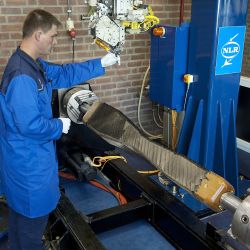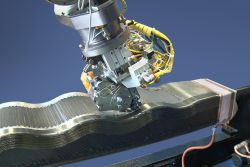
The dry preform of the landing gear component.
NLR has won first place in the ‘Outstanding Paper Award’ for the research paper entitled: ‘Development of Automated Dry Fiber Placement Material, Process and Design TechnologyÂ. The prize was awarded during the SAMPE (Society for the Advancement of Materials and Process Engineering) 2011 conference held in Fort Worth (USA).
The paper stems from European Union collaborative research efforts in the framework of the AUTOW project. AUTOW stands for AUtomated Preform Fabrication by Dry TOW Placement. Dry tow placement is now known as Dry Fibre Placement (DFP), as this is a more commonly used term.
This project is a collaborative effort involving Dassault, EADS Innovation Works, Hexcel Reinforcements, ONERA, Catholic University Leuven, University of Stuttgart IFB, TU Delft, VZLU, Israel Aerospace Industries and Keilmann Sondermaschinenbau KSL. The consortium is led by NLR.
The AUTOW project involves combining two relatively new manufacturing techniques for composite structures: resin injection and ‘automated fibre placement’. Both are rapidly emerging techniques and are of great interest to the aircraft industry, owing the possibilities of using these processes to reduce manufacturing costs.
The innovation within the AUTOW project involves combining both techniques, through which it then becomes possible to develop fibre placement processes using dry fibres, as well as the necessary design methods. The benefits of composite parts made of dry fibres and resin injection compared to the more conventional prepreg autoclave technology include lower material costs, limited subsequent machining, possibilities for extensive integration and production of components with close tolerances. Finally, this technique is highly suited for producing thick-walled composite components, such as landing gear parts, which is an area that the NLR is currently engaged in.
Within AUTOW, NLR was partly technically responsible for developing the DFP capability and for the material and process characterisations. These two activities were closely linked in an iterative process of machine and material adjustments. In addition, NLR was responsible for preparing production for the design of the ‘sine wave rib’, a composite component that serves as a rib in an aircraft wing (see photo’s). NLR produced multiple dry preforms of the sine wave rib, and these were subsequently injected by IAI using Vacuum Assisted Resin Transfer Moulding (VARTM). The sine wave rib was ultimately successfully tested by VZLU.

The making of the dry preform for the sine wave rib on NLR’s AFP machine.
Within this project, TU Delft developed a non-convential steered fibre design methodology, which can be applied in constructions such as fuselage and skin panels.
The DFP technology developed in AUTOW is already being applied in another EU projects, named ADVITAC (Advanced Integrated Tail Cone). In addition, NLR, in the context of developing composite landing gear, manufactured a preform, with the help of DFP, which was exhibited at the NLR stand during the JEC 2011 in Paris.
Meanwhile, virtually all the partners in AUTOW, under the NLR’s leadership, submitted a new proposal in the final round of the European Union’s 7th Framework. The proposal calls for further research focused on Non-Conventional Laminates (alternative fibre webs, but also the renowned AP-PLY), in combination with Dry Fibre Placement. If this project is approved, NLR’s new Coriolis fibre placement machine will be used in the project.

